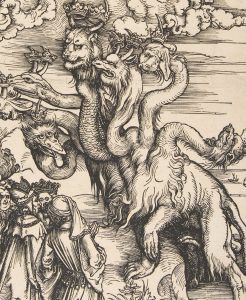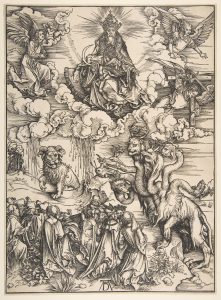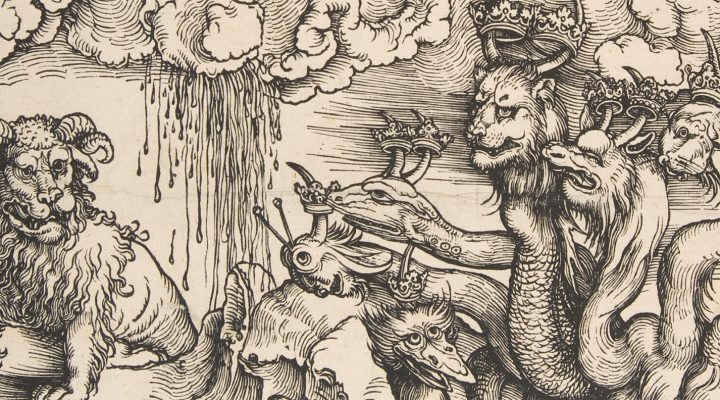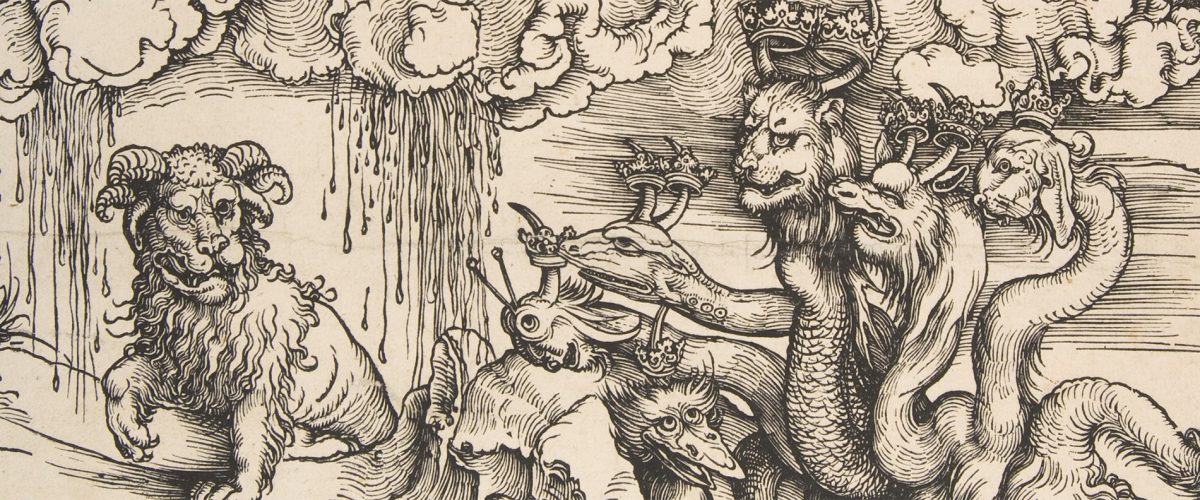John the Revelator warns about the dangers of joining church and state. He thunders: “Beware the sea beast; it has seven heads and 12 horns, and his number is 666. Beware the land beast; it has two horns and is a lamb.” But, more importantly, he points to the “Lamb with seven horns” who is also a “Lion.”
Too often interpreters perceive John as an ivory tower mystic whose experiences gave him mostly insight about a future distant from where he lived. Rather, he was a rip-roaring Christian prophet in the Old Testament mode who confronted the powers of his day with a rip-roaring message about Jesus that got John into trouble with the authorities, which resulted in his banishment to an island. However, by his communicated visions in Revelation, he kept up his resistance to the oppressive state.
His message is not polite, not throwing softballs.
God is good but not tame
Eberhard Bethage, in his biography of Dietrich Bonhoeffer, reports what Bonhoeffer said in a sermon as he saw Germany and the church going in the wrong direction that ended in Nazi domination, “So the more pious we are, the less we have to tell ourselves that God is dangerous, that God is not mocked.”
C.S. Lewis, in the Chronicles of Narnia, describes Aslan, the Lion signifying Jesus in the story, as “good,” but not “tame.”
Through the visions given him, John communicates to his audiences that God is dangerous, not tame. He is also the Lamb sacrificed for us as Revelation proclaims.
Revelation for all time
By God’s revelation, John looked into his time and saw in his setting the realities that always operate in any time. John and present time come together. Beasts and threatening powers gather throughout history. John describes such powers of his own time in terms of images and symbols that take on a vividness that is inspiring, shocking, even frightening.
But we should not push John’s visions off to the future or relegate them only to the past: they are current, describing the present powers the church faces and pointedly describing the overarching victory and reign of Jesus.
“We should not push John’s visions off to the future or relegate them only to the past: they are current, describing the present powers the church faces.”
In the famous chapter 13, he describes the rulers and the state, the state having become the religion and the religion the state. Satan stands on the land and the sea, controlling both the beast rising out of the sea and the beast on land. Satan is in control of them since both beasts readily give their powers to him in order to gain access to his power, and they don’t mind using and excusing evil in the process. The beast rising out of the sea points to people or movements seeking to make others subservient to their autocratic power.
 In John’s time, the sea beast represented the emperor and Rome, an identity affirmed by the seven heads of the beast, reminding an interpreter of a series of seven emperors. The sea-beast’s identification is 666.
In John’s time, the sea beast represented the emperor and Rome, an identity affirmed by the seven heads of the beast, reminding an interpreter of a series of seven emperors. The sea-beast’s identification is 666.
The number six, in apocalyptic numerology, suggests incompleteness, imperfection or even evil. In contrast, the number seven stands for completion or perfection. Multiplication of numbers often indicates a greater intensity. Interpreters describe 666 as a trinity of evil, or simply a multiplicity of evil, or even an unknown mysterious figure. The most likely 666 identity is a symbolic reference to rulers like Nero, the Roman emperor from AD 54-68, who appear throughout history.
Nero was a vicious persecutor of Christians in Rome, and John’s readers and hearers in the churches knew the stories of his slaughter of fellow believers.
Numbers also stood for letters. So if the numbers 666 are put in terms of the corresponding Hebrew letters, Neron Caesar results. In any case, 666 represents hostile, concentrated evil in a person like Nero.
“John takes off their uniforms and suits and goes behind the words to reveal the beasts beneath.”
More than one “Nero” exists at any stage in history. Vladimir Putin certainly is the sea beast, and Stalin, Hitler, Pol-Pot, slavery, segregation, racism, and many other oppressors and oppressions follow the way of the sea beasts. They come in striking uniforms or two-and three-piece suits, speaking enticing, protective words of power. John takes off their uniforms and suits and goes behind the words to reveal the beasts beneath.
The sea beast has 10 horns. Ten is the number in apocalyptic writing that characterizes something as human, while horns represent power, so the beast has human power. The land beast is a lamb with two horns. Two represents companionship or added strength. In companionship with the sea beast, it shares the sea beast’s power. Since the land beast is in the form of a lamb, it is a caricature and contrast of Christ the sacrificial Lamb. Therefore, the land beast represents religion. Jesus as Lamb has seven horns. Since the number seven is for perfection or completion, Jesus is the true, complete power: Lamb power.
Lamb power
Lamb power is the greatest power of all. He turned a Cross into the greatest victory. He is self-giving. He is love; love that is not a mushy sentimentalism, but love defined by his life and teachings and ultimately by the Cross.
“People can put a two-horned beast in his place and pretend that it is he.”
This is tough love. He is truth, and it is the truth that sets free. He is life, and only he can give it. He is Master, King, Deliverer and a number of other descriptive titles. He is for others, even enemies. His kingdom is now and present here, superseding any other kingdom and gaining loyalty first before other loyalties. He never can be defined by the state, nor will he be used by the state. But people can put a two-horned beast in his place and pretend that it is he.
 The two beasts combine state and religion. The two-horned lamb identifies with the will of the sea beast: “Caesar is Lord,” emperor worship proclaimed. “Jesus is Lord” did not work for the powers that were. Disturbers of Rome’s status quo became enemies to local powers who did not want their relationship with Rome and Roman society to decline and rob them of benefits they might receive from the state.
The two beasts combine state and religion. The two-horned lamb identifies with the will of the sea beast: “Caesar is Lord,” emperor worship proclaimed. “Jesus is Lord” did not work for the powers that were. Disturbers of Rome’s status quo became enemies to local powers who did not want their relationship with Rome and Roman society to decline and rob them of benefits they might receive from the state.
If the churches of Revelation in their respective cities had honored Caesar more than they did Jesus, as well as participating reasonably in Roman cultural and religious activities, they probably would have passed as acceptable. In other words, “Adjust Jesus to fit in and you will be OK.” The pressures for the churches to conform were heavy as chapters two and three of Revelation, the itemized messages to the seven churches, confirm.
“Whenever the church attempts to wed Jesus to the state, the stage is set for two beasts, state and religion, to combine or to begin to combine forces.”
Where does the sea beast get its standing? Since it arises out of the sea, which is humanity, it has the power the people give it. Satan gives the authority under his guidance to use that power. Whenever the church attempts to wed Jesus to the state, the stage is set for two beasts, state and religion, to combine or to begin to combine forces. The sea beast will turn the church into the land beast or some semblance of it and subjugate it to the state’s thrust and wishes. It may even let the land beast use its own name, but that only puts false clothes on the religion while it becomes the land beast underneath.
John did not have any difficulty identifying the beasts in his own time, and neither should we. The Lamb’s light shines on authorities that are oppressors. Evil forms itself in institutions, movements and philosophies, and manifests itself in a leader or several leaders with destructive commitments.
The beast of Christian nationalism
Thankfully, as John’s vision to the churches indicates, Jesus dwells with his churches in his life, death and resurrection to keep them from following the two-horned lamb. Of course, the church must be committed to the Jesus who really is, to seek to live by the life, death and resurrection of Jesus in historic revelation. That is a great challenge, because cultural and political powers are strong. Lamb power or beast power, which is it to be? Christian nationalism is taking the shape of the two-horned lamb.
“Christian nationalism is taking the shape of the two-horned lamb.”
An objection may be lodged: Wedding the church and the state together is not the same as wedding emperor worship and the state together. Do we need to be reminded of Nazi Germany or the other lessons of history up to the present time?
The disciples wanted Jesus to do that, to restore the kingdom to Israel. They still perceived Jesus’ movement becoming another David kind of kingdom in some way. Not so, Jesus said, go and be my witnesses everywhere. Be the church.
Jesus in his ministry never advocated that his people should aspire to the powers of the state, nor did Jesus himself so aspire. Through our sometimes blurred vision, we glimpse the real truth, and hopefully embrace it, that the church in Jesus’ power is much greater than the church adopting state power.

“The Beast with the Seven Heads and the Beast with Lamb’s Horns,” 1511, Albrecht Dürer. Metropolitan Museum of Art.
Revelation calls the church to take on fully the victory of Christ. John’s received message is not about defeat; it is about the victory and reign of Jesus as he leads his people to the promised land, even through severe suffering and their own failures.
This is a remarkable affirmation given the powers against the church in John’s situation. Revelation 5:5 says that the Lamb “has conquered,” not that he waits to conquer at some point in the future. John’s visions actually tell us that Jesus rules, not the beasts, as Matthew also tells us that “all authority” in heaven and earth belong to Jesus now.
The Baptist Joint Committee report about January 6 and Christian nationalism reveals the movement’s attempt to pull the sea beast and land beast out of our confused humanity. The church never can be the state, and the state cannot be the church. At times they can cooperate for good, but the two kingdoms are different. The church is not perfect at loving its friends and its enemies and the least of these and turning the other cheek. Nevertheless, that must be the commitment in the life of the Lamb. No off-ramp from those commands exists. Jesus’ will prevail over the sea beast and land beast. John affirmed that to be true by the revelation given him, even with a powerful state looming over tiny congregations.
Seeking power-over in the name of Jesus and not Lamb power is an effort to give Jesus another identity, finding benefit in a counterfeit, two-horned land beast that looks a little like Jesus but is not.
Powers want Jesus on their side if they can have him on their terms. Churches seeking to garner state power expose themselves to use by the sea beast. Rather, the church puts on the life, Cross, and resurrection of Jesus and not the robes of the state. Jesus will not be shaped. The church submits itself to be shaped by the Lamb and will move the world by Lamb power. But beware the temptation of beastly power.
Joe Blair served as chair of Christianity/religion departments at two Baptist universities. He was a professor for 26 years, teaching courses primarily in the New Testament disciplines. He has written for the BAPTISTWAY Press and for Baptist papers. His Introducing the New Testament is a basic, introductory level text that both students and laity have found helpful.
Related articles:
Christians should study Revelation (but not for the reason you may think) | Opinion buy Corey Fields
From Romans to Revelation: How Christians began to stand against the Emperor | Opinion by David Jordan
Reading Apocalypse in an Age of Revelation: the uncovering of white Christian nationalism | Opinion by Greg Jarrell


